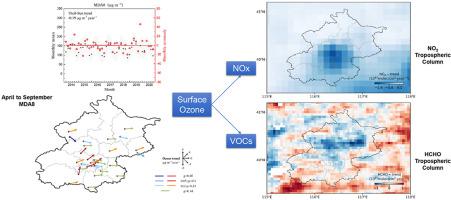Atmospheric Environment ( IF 5 ) Pub Date : 2021-06-12 , DOI: 10.1016/j.atmosenv.2021.118556 Jie Ren , Yufang Hao , Maimaiti Simayi , Yuqi Shi , Shaodong Xie

|
The surface ozone (O3) spatiotemporal distribution, variations and its causes in Beijing in 2014–2020 are revealed by quantitative estimates of the trends of 12 ozone metrics relevant to human health and tropospheric NO2 and formaldehyde (HCHO) column concentration, based on the air quality monitoring network data and satellite retrievals from the Ozone Monitoring Instrument (OMI). Results showed that the maximum O3 concentrations decreased slightly since 2014. The annual 90th percentile of the daily maximum 8-h average (MDA8) O3 and the “ozone-season” (April–September) MDA8 decreased by 0.32 and 0.19 μg m−3 year−1, respectively. The changes in Beijing contrast the widespread and significant O3 increases in the Beijing–Tianjin–Hebei region in recent years. However, significant positive trends in MDA8-90th and ozone-season MDA8 were observed in 7% and 14% of monitoring sites in Beijing (p < 0.05), most of which are located in urban areas and suburbs close to urban areas. The spatial distribution of high O3 values in Beijing has changed significantly. The areas with high O3 concentrations shifted from the northern suburbs (Changping and Miyun districts) to the northeastern and southwestern suburbs and the east of the central urban area. The ozone-season NO2 and HCHO tropospheric columns showed reductions of 4.2% and 0.4% year−1, respectively, from 2014 to 2019 in Beijing, which suggested that the decrease in NOX emissions was much greater than the decrease in volatile organic compound (VOC) emissions. Such an extremely inappropriate control ratio of ozone precursor NOX/VOCs led to an overall trend of slow declining fluctuations of O3 and an increasing trend of individual sites in Beijing. Obviously, the reduction of VOCs in Beijing is far from sufficient, and the significant decrease of Beijing's O3 concentration can only be achieved by a drastically reduction in VOC emissions.



























 京公网安备 11010802027423号
京公网安备 11010802027423号